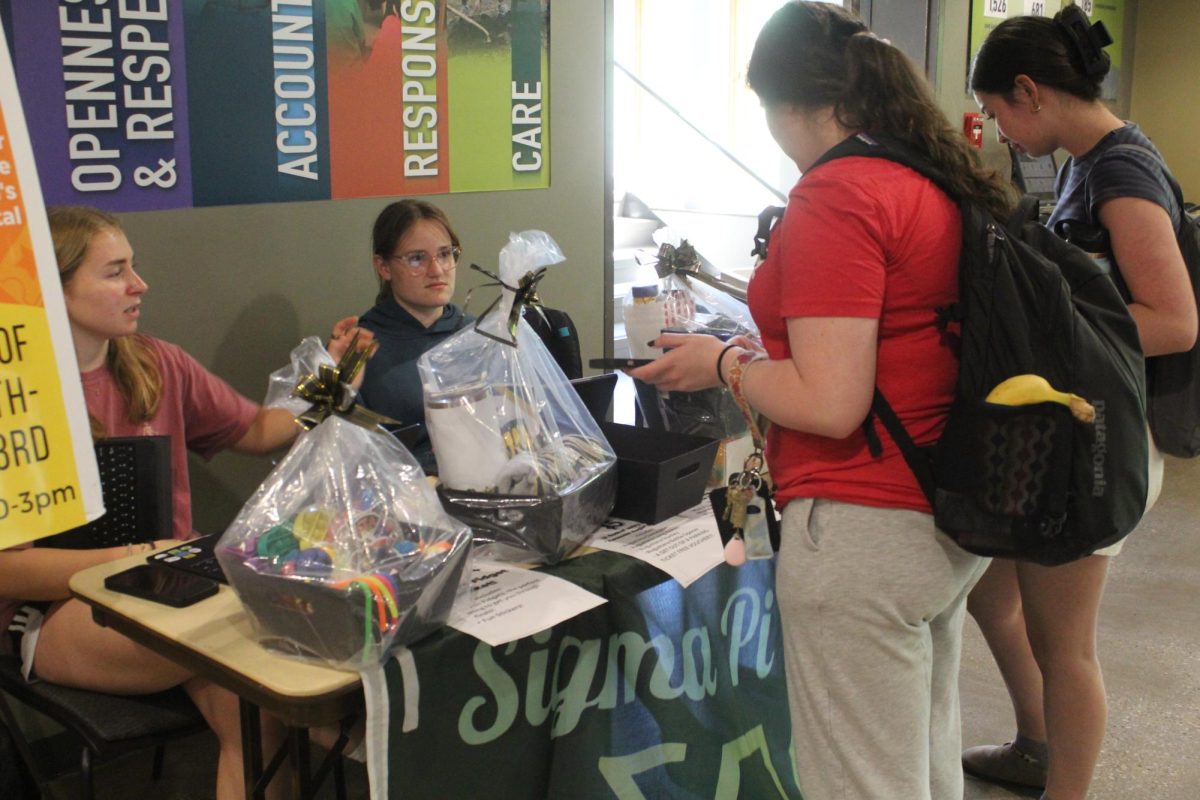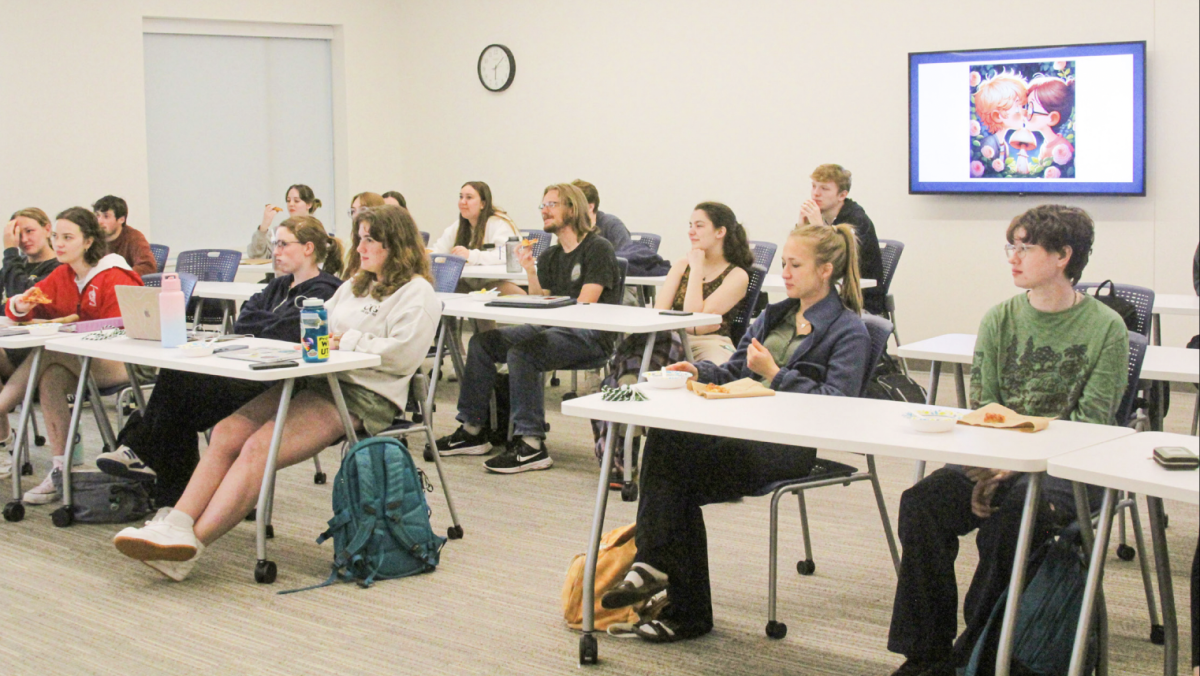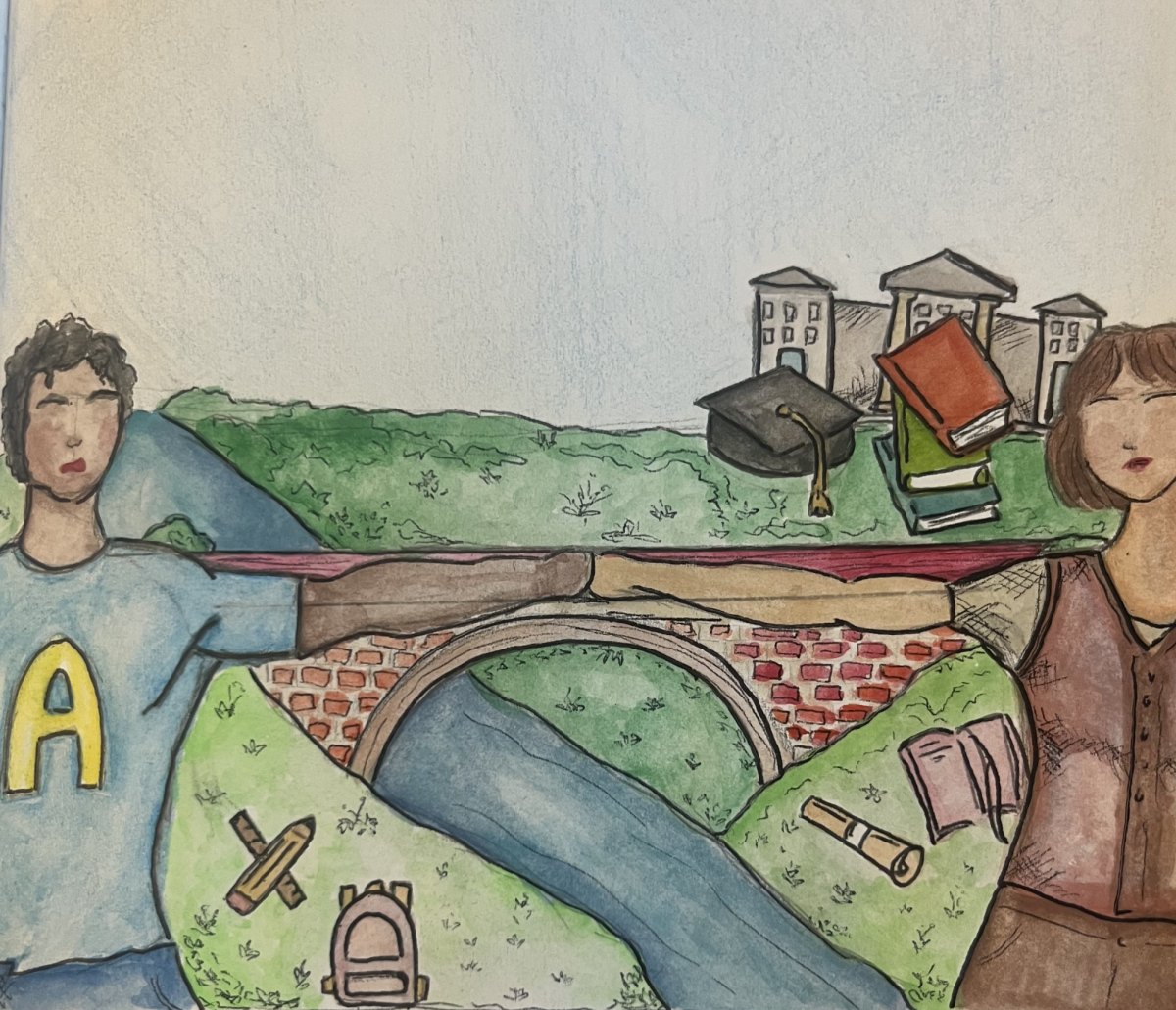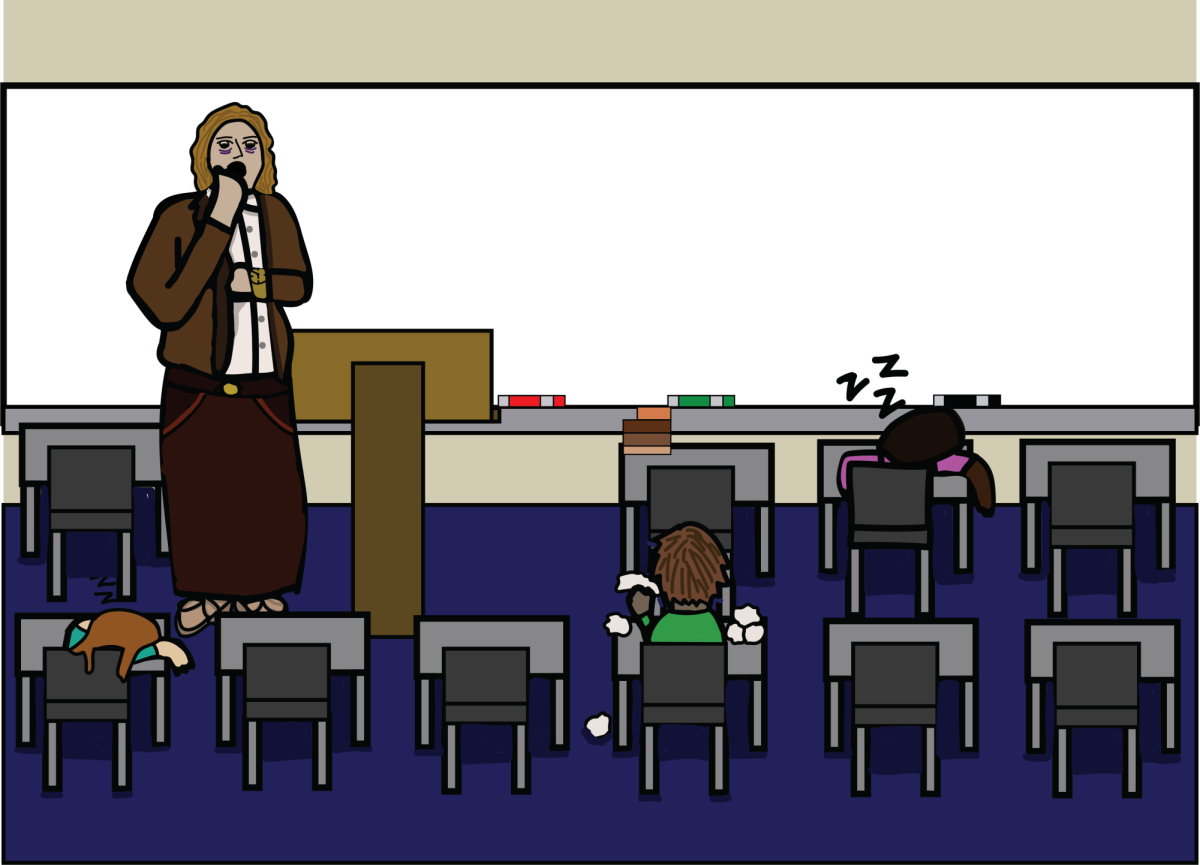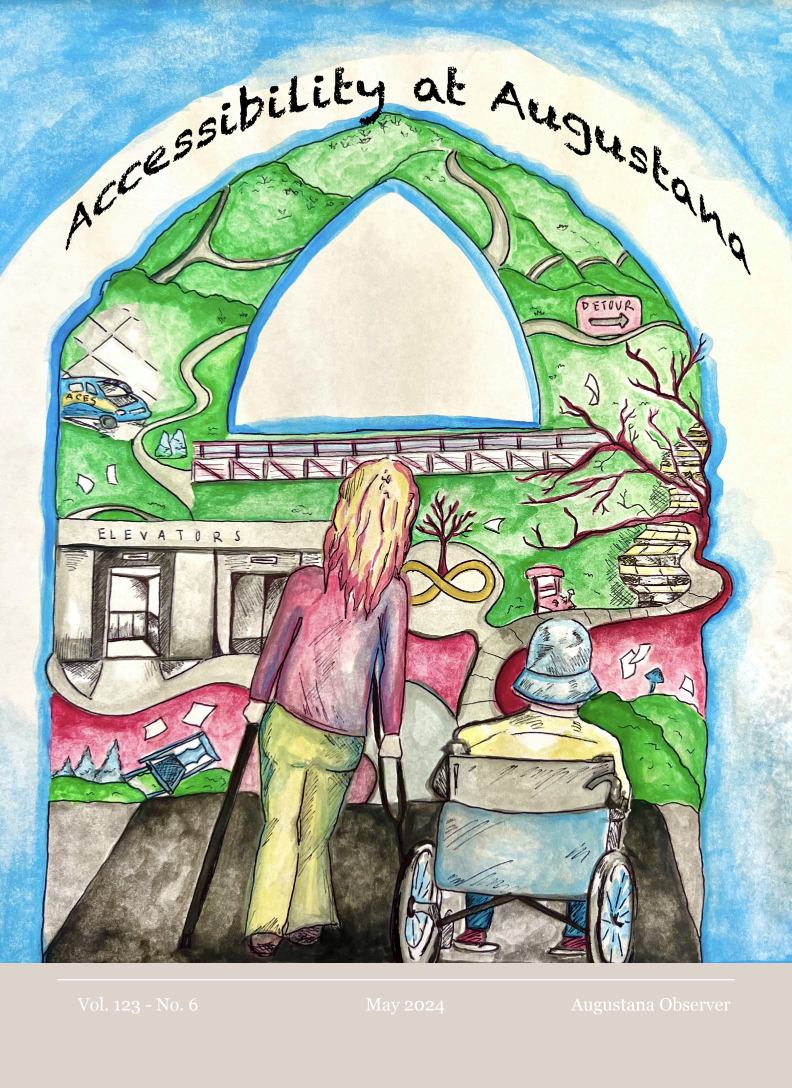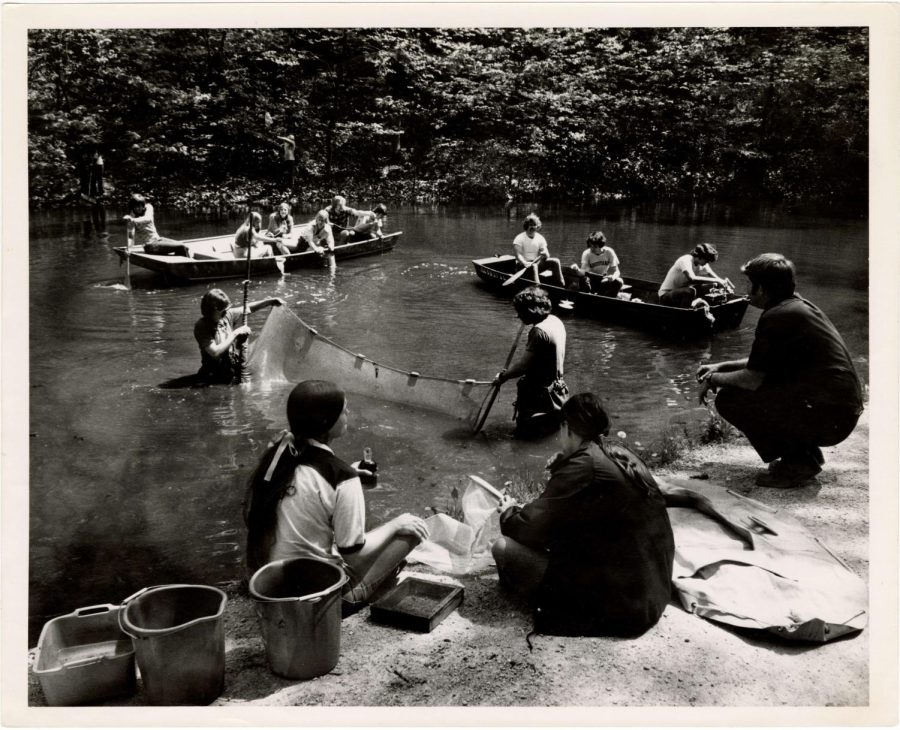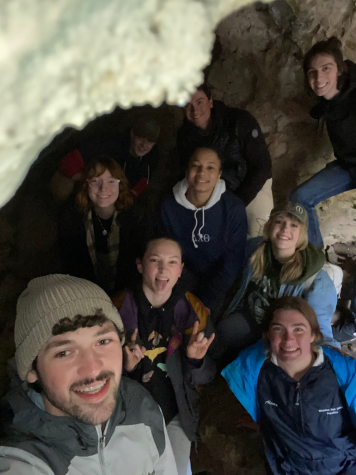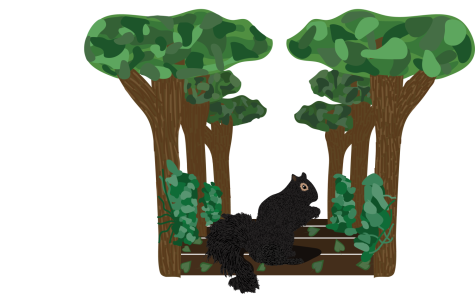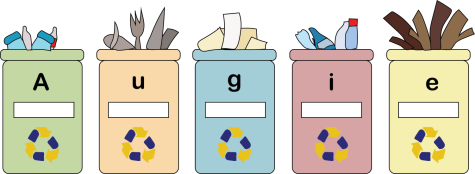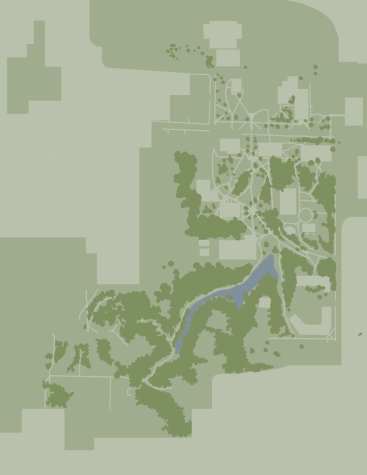Slough water ebbs and flows through history at Augustana
View of the Slough and the Swanson bridge in the fall, 2011. Courtesy of Augustana College Special Collections.
May 17, 2023
It’s hard to imagine a day at Augustana without the Slough. Students walk along the pathway, watch the colors change out their windows, joke about how it smells and race in boats down the water during Homecoming. But few know the depths of the Slough’s history and all that lurks beneath the water.
The Slough’s history is caught up in the long, continuous process of campus construction projects, which shaped and adjusted the waters to how it is now. The origin of the Slough goes back to a campus that would be unrecognizable now.
Much of campus was once covered by water, either by streams or by Lake Sylvia, which no longer exists.
“There are streams that naturally came down through the campus and went to the Mississippi,” Kai Swanson, special assistant to the president, said. “But starting in the early 1900s, the city started pushing that stream back, because it wanted to smooth out 7th Avenue and make it easier for commercial traffic. And then the college just continued that.”
As academic buildings were constructed, water was put into underground pipes or pushed back across campus. And when Westerlin and Erickson were constructed, the Slough and its pathway offered a connection between the residential and academic areas of campus.
The name Slough is a testament to students and alumni. In the 1990s, a marketing consultant wanted the name changed to The Ravine, The Ravine Pond and The Ravine Walkway. But students and alumni never gave up the name Slough.
“If you look back far enough, I can find you these campus maps that say ‘Ravine,’ but no student ever called it that,” Swanson said. “A slough is off the main channel, which I think is poetic because if you walk the Slough Path, you’re stepping off the main channel.”
The current Slough appearance is due in part to the Tredway Library construction project, when the Slough pathway was paved and the waters were extended further out in the quad. According to Swanson, the change to the Slough’s limits was partially for aesthetic and partially for flood-control.
“The top of the downspout may have been lowered a bit to make it a little shallower, but by adding the surface area, it can accommodate more severe weather events,” Swanson said.
Underneath the ever-changing waters is an ecosystem of fish, invertebrates, turtles, frogs, algae and more. However, the top area of the Slough, by Naeseth, is very different from the bottom pond by Tredway in terms of creatures and water quality.
Dr. Kevin Geedey, professor of biology, has collected and analyzed Slough water quality patterns with his students for years. Geedey last tested the waters in fall of 2021.
According to Geedey, the top part of the Slough has poor water quality and is populated by pollution-tolerant creatures who can survive the low oxygen and high chemical levels.
“The water all the way upstream at the top of the Slough Path is usually pretty gnarly. It’s often high in ammonia, and it’s often low in oxygen, and it’s often high in nitrate and phosphate,” Geedey said. “All of those are indicators of excessive fertilizers or excessive runoff from leaky sewage infrastructure or leaky septic tanks.”
As the water flows across campus, the ecosystem processes improve the water quality significantly. Geedey estimates that by the time the water hits the drain headed for the Mississippi, it is about 25-30% cleaner than when it entered campus.
Senior Paige Lundborg, who looked at the water quality data in Geedey’s class, said the analysis caused her to view the Slough differently.
“I think knowing some of the chemistry behind it has slightly altered my view, because I just get a weird feeling when I see people jump in it,” Lundborg said. “In terms of a healthy water system it’s not the best, and there is room for improvement.”
According to Swanson, the college doesn’t test water as an institution because it isn’t used for any human purposes. However, the data collected in classes like Geedey’s has been shared with the college for decades.
One thing the Slough is famous for on campus is its smell, which comes from decomposition within the Slough’s ecosystem. This smell is worsened in the fall, as leaves break down in the water. However, as bad as the smell can get at times, it used to be much worse. Swanson said when he was a student in the 1980s, the sewage line running underneath the water would leak, adding to the odor.
According to Geedey, the smell is strongest where the water quality is poorest. The higher levels of ammonia and nitrate in the upper areas fuel more bacteria, which decomposes more and produces a greater smell. Low oxygen levels also worsen the odor, as well as make it impossible for fish to survive in the upper part of the Slough.
One way Augustana has worked to improve the Slough’s quality is by placing aerators, also called bubblers, in the water to increase oxygenation.
“What the bubblers do is take water from the bottom that may have low oxygen conditions and push it back up to the surface, where it’s going to get exposed to atmospheric oxygen and kind of recharge,” Geedey said. “Those bubblers, which the college is maintaining and paying for, are a well-established and effective strategy of trying to improve water quality and maintain fish populations.”
Maintaining fish populations is important not only to the Slough ecosystem but also for students and faculty, because the fish keep the mosquito population on campus low.
Not all fish are beneficial within the Slough’s ecosystem, though. For instance, goldfish are an invasive species in the Slough. What likely started as students adding their pets to the Slough at the end of the school year has caused larger problems for the water quality, because goldfish stir up sediment at the bottom of the Slough.
The goldfish population was reduced in 2017, when a pipe beneath the Slough collapsed, which flooded the lower campus and drained the waters from its bed. In the aftermath, goldfish were replaced with more native fish and the campus community saw how Augustana looks without the Slough’s waters.
The city’s sewer pipe underneath the water is accessible through the cement square block in the middle of the Slough. According to Swanson, the city is currently looking to improve the pipes so there isn’t another collapse and flood like in 2017.
“The city just made a decision to invest more in that system so that it won’t happen again,” Swanson said. “I don’t know when the work is going to begin on that, but they’re going to either reinforce, bypass, or both, those sewer lines.”
Going forward, certain issues within the Slough’s water can be addressed by students, such as littering and not donating pets like goldfish to the water. Other issues need to be addressed through community involvement, because the water comes into the Slough from the surrounding neighborhoods. Aging infrastructure and pipes, litter and road salt usage all contribute to poor water quality. Even how storm drains collect water, running across asphalt instead of being processed by soil first, impacts what is in the water.
Although the Slough is beautiful and the Slough Path makes for a picturesque walk to and from class, it is important to realize that the Slough is also an environment similar to a typical forested pond.
“In a lot of respects, the Slough looks like what a normal pond looks like,” Geedey said. “To us, it may just be a little stream that gurgles past or a pond we walk past on the way to class, but there’s this whole drama of ecosystem processes and life and death that’s going on in that water all the time.”
Understanding what the Slough is and isn’t is important for the campus community to fully appreciate it. Its shape, color and smell are different from an artificial water feature, because the Slough is a complex piece of nature and of Augustana’s ever-changing history.





